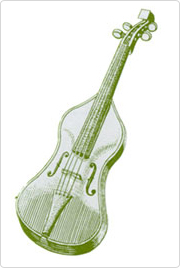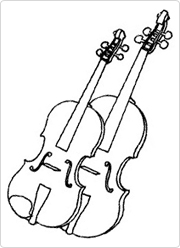
Viola Learn More
Share
The viola is sometimes not as prominent as the other string instruments, it's smaller family member Violin and larger family members, Cello and Bass. Yet it's rich, dark timbre and interesting history deserve a closer look. Do you know, for example, that Bach, Mozart, and Beethoven all played the viola? Or that the famed instrument maker, Stradivari, also made violas that are worth more than his violins?
INTRODUCTION TO THE VIOLA
The viola is the middle voice of the string family, sitting comfortably between the violin and cello. More specifically the viola’s range is a perfect fifth below the violin’s, having the same A, D, and G strings as the violin with the addition of a C string (an octave below middle C). It has the same four strings as the cello (C, G, D, A), but is one octave higher. As the middle voice in a string section, the viola similar to the alto voice in a choir. In fact, the viola uses its very own clef, called the alto clef.
How To Read Alto Clef:
Alto clef may seem unusual, but it is just as easy to learn as the treble or bass clef. The middle line, pictured below, indicates middle C. Once you know this, you can simply follow the lines up and down to find the other notes.
Violas are held almost exactly the same way as violins: to one’s left side, over the shoulder, and under the chin. In fact, the two instruments are so similar that many people have trouble telling them apart! This makes sense considering that they share the same playing position as well as three strings, but the viola’s slightly larger size creates a unique sound. A full-sized violin has a body length of 14 inches whereas there is no official full size for a viola. Violas found in orchestras generally range in size from 15 to 18 inches, with the most common size being 16.5 inches. While a couple of inches may not seem like a big deal, that extra size is the crucial element in the creation of the viola’s unique sound, It's chocolaty
sound draws people to play and listen to the viola.
MORE BACKGROUND
Would you believe that the beautiful tone of the viola has often prevented it from achieving the same fame as the violin and cello? This makes sense if you think again about the vocal equivalents of each string instrument. The violin is the soprano voice of the strings and the cello is the tenor voice of the strings. It is very easy to hear sopranos and tenors in a choir and even basses for that matter, but what are the altos up to? Much like altos in a choir, the viola often fills in harmonies in an orchestra. Its dark and chocolaty
sound blends the string sections together and gives body to the orchestra as a whole. You may not notice them at first, but should you lose your alto voice/violas, your ensemble would sound hollow and deflated! Violas really are the (pardon the pun) the unsung
heroes of the orchestra!
THE UNSUNG HERO
The viola is hundreds of years old. In fact, some reports say that it is the oldest of the string family. The viola has been utilized as a harmonic (as opposed to melodic) instrument by composers for hundreds of years. This is the main reason that people are less familiar with it than the violin or cello. The viola has less solo music written for it than the violin and cello, and while it does have more solo music written for it than the string bass, the viola is still less recognized than the bass. Besides being visually hard to miss on stage, basses are regularly seen performing in various popular music groups such as jazz ensembles and pop/rock groups.
This lack of star power has also contributed to something curious amongst violas and viola bows. Because of their role as harmonic instruments, violas were not made in as large numbers as the violin and cello. Great old violas and bows are extremely rare and thus a viola made by Stradivarius or Guarnerius is worth many times more than a violin of the same condition. Fortunately, there are several viola makers today that specialize in producing great violas, making for many happy violists.
A term used to refer to a variety of bow and string instruments
Nobody knows for sure where and when the first viola was created. However, it is known for a fact that the instrument was in use in northern Italy around the same time as its cousin, the violin (i.e. the first half of the 16th century). Although the instrument is called "viola" in both Italian and English, use of the term only became commonplace from the 18th century onwards. Up until then "viola" was used to refer to a variety of bow and string instruments (i.e. stringed instruments played with a bow)-which should be obvious if you consider the example of the instrument called the viola da gamba (which means "viola for the leg"). In French, violas have been called "altos" since the Baroque period, because they are the members of the violin family responsible for playing in the midrange. The German word for viola ("bratsche") is said to come from "viola da braccio" ("viola for the arm"), which is what instruments in the violin family were referred to in Italy during the 16th and 17th centuries.

An early viola. Its sloping shoulders show its lineage from the viol.
How the structure of the viola has changed over the years

Size comparison between a viola and violin
The four strings on a viola are tuned in fifths to the notes c, g, d', and a'. This tuning is exactly one fifth below the violin, expanding the instrument's low range. Of course, while the instrument itself is larger than a violin, violas are not kept to strict size standards even today. Compared with the bright sound of violins, violas produce a refined and more somber timbre. This is likely due to the compromise that had to be struck between acoustics and size.
The structure of the viola has changed over the years in a similar fashion to that of the violin. The body of the instrument was reinforced in order to allow it to play louder music more evenly. The neck was attached at a sharper angle and the bridge was made more durable, allowing for the strings to be strung more tightly and dramatically increasing the instrument's volume.
Should I Pick Viola?
Should you play viola? Well, the most important question to ask yourself is, Do you love the sound of the viola?
As I mentioned earlier, the viola and violin are played in a similar manner. The main difference is that the viola is slightly larger, meaning that you must place your fingers slightly farther apart when playing viola than on the violin. Since the instrument is larger, is it also heavier and requires thicker strings and heftier bows.
Viola bows generally weigh anywhere from 69 to 74 grams—about 10 grams heavier than violin bows. One way to tell a viola bow apart from violin bows is by looking at the frog (the part of the bow that is held in the hand). The frog on a viola bow is rounded while the violin bow is pointed. The cello bow also has a rounded frog, but is shorter than both violin and viola bows and weighs around 10 grams more than a viola bow.
Another major difference in playing viola is the use of the alto clef. Alto clef is easy to read (with a bit of practice) once you know that the center line on the music staff is middle C. Although the alto clef was used quite widely in the Baroque period, it is rarely used by instruments other than the viola in modern times. The trombone and cello sometimes use tenor clef, which looks like an alto clef floating one line higher on the music staff. It should be noted that violists also get to use treble clef on occasion when they play in higher registers.
The last major difference between playing the violin and viola is in the production of sound. Generally, because of its thicker strings the viola speaks
slower than the violin. That is, it actually takes a bit longer to hear its sound from the time the bow touches the string. Violists need to be mindful of this since we don’t want to be behind the violins in the orchestra! They also need to learn to play slightly shorter strokes than on the violin depending on the desired sound. The viola can be easily lost in the sound of an orchestra, therefore they need to be able to stop and start bow strokes clearly in order to be heard. Violists have to be masters of articulation! Remember that the viola is the middle voice in the string section. They are often the mediator between the articulations of the cellos/basses and the violins (It is no coincidence that violists as people tend to be calm and stable!) Along with sound production comes vibrato! Again, vibrato on the viola is very similar to that of the violin, but it tends to be slightly slower and wider to match the larger size of the instrument. Of course vibrato is purely personal, but a slower and wider vibrato achieves the darker tone that is more commonplace on a viola.
IMPORTANT VIOLISTS
Would it surprise you to know that Mozart, Beethoven, Dvorak, Paul Hindemith and even Paganini played the viola? It’s true! Mozart and Beethoven loved to sit in the middle of the sound when performing their own string quartets. Dvorak was a very good violist and worked as a viola player early in his life. Paganini studied with Alessandro Rolla, a famous viola virtuoso and composer, who most likely introduced Paganini to the wide technical possibilities of the viola. It was Paganini who commissioned Hector Berlioz to write Harold in Italy, a symphony that features a solo viola. As the story goes, Paganini thought that the solo viola part written for him was not flashy enough and he decided to write his own viola composition. The result was the Sonata per la Grand’Viola, a piece in the same vein as Paganini’s virtuoso works for violin.
Famous Composers Who Played Viola:
- J.S. Bach
- Ludwig van Beethoven
- Benjamin Britten
- Antonin Dvorak
- Joseph Haydn
- Paul Hindemith
- Wolgang Amadeus Mozart
- Franz Schubert
These violists have improved the playing of viola in the last 100 years. There are good contemporary violists too: Yuri Bashmet, Tabea Zimmermann, Roberto Diaz, Kim Kashkashian, Nobuko Imai, and Helen Callus, as well as Lionel Tertis, William Primrose.
